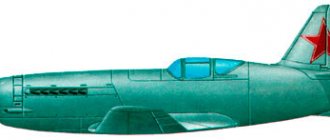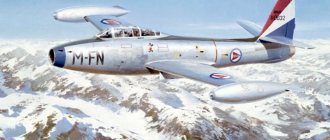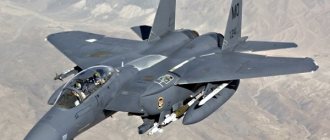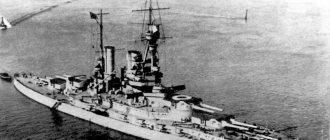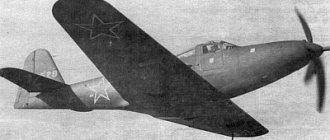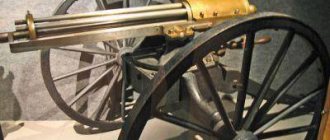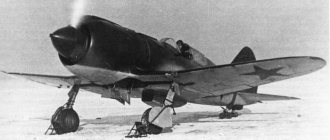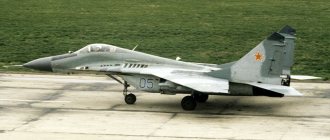Project and prototype aircraft
Albatross DV project and experienced fighter. The creation of the aircraft as an improved modification of the Albatros D III was assigned to IdFlieg at the beginning of 1917. The design was carried out under the direction of R. Thelen.
The general layout of the aircraft was retained, but significant differences were introduced into the design:
- a new Mercedes D IIIa engine was installed (take-off power 160 hp, power at an altitude of 1000 m - 170...180 hp);
- the diameter of the propeller spinner was increased and the hood was redesigned accordingly;
- the distance between the wings has been reduced by 120 mm;
- the lower wing (narrow single-spar) is attached to the rods on the lower part of the frame with detachable connections, the joint area was not sewn up with fairings (reducing weight, simplifying assembly and reducing cost);
German pilots at the Albatross DV fighter - the simplified design of the lower wing joint without fairings, which worsened the aerodynamics of the aircraft, is clearly visible Photo: simhq.com
- a new fuselage was made with a completely elliptical cross-section (without flat side panels), its design was lightened by 32 kg compared to the original, while its strength became better due to the introduction of another pair of spars on the sides;
- thanks to the change in the fuselage section, the cabin cutout became deeper, which made it easier to enter and exit while wearing warm clothing;
- behind the cockpit there is a fairing-headrest similar to the D IV aircraft, but with an increased height;
- a completely new stabilizer design was made with a smaller area due to reduced curvature of the leading edge and with plywood sheathing;
General view, dimensions and design of the Albatros DV and D Va fighter Figure: jitterbuzz.com
- RV rocking chairs are reinforced;
- a fairing is installed at the junction of the stabilizer and the fuselage;
- the ventral fin is new with a beveled trailing edge (previously it was straight in the area of the trailing edge of the fin)
- the aileron control wiring rises into the upper wing in the center section area, and not at the outer struts, as on previous aircraft, which made it possible to remove the through opening in the upper consoles in the area where the cables exit to the aileron rockers, which were replaced by “quarter rollers”;
- fairings were installed in front of the aileron rockers;
- The dimensions of the general public school have been changed.
Albatross DV fighter prototype Photo: wwi-models.org
The aircraft was built by the Johannishtal plant and made its first flight on 04/15/17.
Before the end of April 1917, the aircraft was transferred to official type tests at IdFlieg. Main test results compared to the Albatros D III aircraft:
- maximum and cruising speeds at an altitude of 1000 m increased by about 10 km/h without increasing fuel consumption (due to an increase in the completeness of its combustion and a decrease in aerodynamic drag);
- due to the increase in cruising speed, the range increased by 50 km with the same flight duration;
- the ceiling increased by 450 m;
- the time to climb 1000 m increased by 0.5 minutes, 3000 m – by 5 minutes, 4000 m – by 3.5 minutes, 5000 m – by 5 minutes. (data on serial vehicles);
- horizontal and vertical maneuverability, as well as acceleration data, have deteriorated.
During the tests, the vehicle was flown over by specially assigned combat pilots, incl. the best German ace, the commander of the JG I squadron, M. von Richthofen, who gave him a completely negative assessment.
Type tests also included static strength tests - until failure. But at the insistence of the development company, only the fuselage was tested - as the only new unit.
However, the aircraft was accepted into service and received a large order for its production, which began with a hidden defect in the aircraft - insufficient torsional strength of the lower wing.
Full hood" of the Albatross fighter DV W.Nr. 2065/17 pilot Hans von Hippel from the German Air Force Jasta 5 squadron - 1918. This was not the only accident of this pilot, but in this case he was not to blame - in a maneuvering battle the lower wing collapsed from overloads and he miraculously succeeded plan from a height of 1500 m Photo: jasta5.org
Albatross bird of prey
In Germany, as in Russia, combat aircraft were usually named after their creators. Sometimes the Machines bore “geographical” names indicating the location of the enterprise that built them. The first group includes the “Junkers”, “Fokkers”, “Simmens-Schuckerts”, etc., the second - the “Brandenburgs”, “Goths”, “Friedrichshafen”, “Pfalz”. The exception to the rule was the “albatrosses”, the Johannestal aircraft. These beautifully named machines formed the basis of German fighter aircraft in the First World War. Most of the German aces of those years owe their title to them.
was founded in 1910 by Berlin entrepreneur and aviation enthusiast Walter Huth. At first, this small enterprise built French training biplanes Farman-4 under license. Since July 1914, the plant switched to producing Fokker monoplanes and two-seat Albatross reconnaissance aircraft BI
In February 1916, the first biplane fighters appeared on the Western Front: the French Nieuport XI and the English De Havilland II. These highly maneuverable vehicles, created taking into account the experience of early air battles, immediately “took the German Fokker and Palatinate monoplanes out of the game.”
In response to the enemy's challenge, the German command sent out an urgent order to all Reich aviation companies for the development of single-seat biplane fighters with synchronized weapons. Halberstadt was the first to complete the task. Both aircraft were mass-produced, although they did not have any noticeable advantages over the Anglo-French aircraft. Anthony Fokker equipped his fighter with a star-shaped rotary air-cooled engine.
Halberstadt engineers took a different route, relying on a water-cooled in-line engine, more powerful, but also heavier. The loss in weight could be compensated for by aerodynamic perfection. In-line engines provide maximum possibilities for this. But at Halberstadt they were lost. The plane turned out to be angular and unsightly. The abundance of braces, open rods and protruding structural elements created such resistance that, despite a significant superiority in engine power, it was slower than the Nieuport.
However, chief designer Robert Thelen managed to achieve an optimal balance between the aircraft design and engine capabilities. In April 1916, he, together with engineers Schubert and Gneiding, developed a project for a fighter with an inline six-cylinder Mercedes engine. The fuselage in profile resembled an elongated drop. Throughout its entire length it had a rigid working lining. The engine was carefully hooded.
In general, the car turned out to be very aerodynamic, which was confirmed by prototype tests. The plane was recognized as the best fighter in Germany. In July, the company received an order for 50 production copies, and in September they were waiting for the front.
On their first combat mission, the new fighters shot down five De-Havillands without losing a single aircraft.
The fighter, named "Albatross" D.1, was a classic single-pillar biplane of all-wood construction. Semi-monocoque fuselage made of ash frames and stringers with hot-formed plywood skin. The sheathing sheets were fastened to the frame with nails and glue. The streamlined shape of the fuselage was slightly disrupted by the protruding engine cylinder block and the twin Spandau machine guns placed on top of the hood. However, there was a reason for this. Open cylinder heads received additional cooling by incoming air flow. Thus, in addition to operational convenience, this made it possible to reduce the area of radiators and, accordingly, reduce drag.
Open machine guns made it possible to eliminate delays and problems right in flight. True, this required extraordinary dexterity from the pilot. The German Spandau machine gun was an aviation modification of the well-known Maxim, equipped with a remote trigger, a synchronizer and converted to air cooling. Between the engine and the cabin there were machine gun cartridge boxes, gas and oil tanks.
The cabin equipment is rather poor (see picture), typical of those times. The instrument panel, as such, was missing. The pilot had only a tachometer (in the center), a gas gauge, water temperature and oil pressure indicators at his disposal. Some cars were also equipped with a compass.
The wings are two-spar wooden with a canvas covering. The spars are box-shaped with pine shelves and plywood walls. The ribs on the upper wing are made of linden with ash edging and lightening holes. The bottom ones are solid plywood. The front edge is a pine strip, the back edge is soft wire, which is clearly visible from the characteristic “waves” formed from the tension of the skin. The wing profile is thin convex-concave with a relative thickness of 5%. The racks are made of drop-shaped pipes.
The rigidity of the biplane box and chassis bogie was ensured by cross steel braces. The fin, consisting of a pine frame and plywood sheathing, was glued integrally with the fuselage. The stabilizer had a wooden power frame and fabric covering. The rudders and ailerons are welded from thin steel pipes and covered with fabric. The chassis is tricycle, of the usual type with rubber cord shock absorption.
This is, in general terms, the design of the first Albatross, uniform for the entire family of these machines.
In the days when the “D-First” were undergoing baptism of fire near Verdun, Robert Thelen created an improved version of the fighter, designated by the serial index “D.II”. In order to improve visibility, the --shaped struts of the upper wing were replaced with “N”-shaped ones, installed with camber outward. The wing itself was lowered to the pilot's eye level. No one doubted such innovations, and the aircraft was immediately put into production.
During serial production, two side radiators were replaced with one, inscribed in the center section profile of the upper wing. Contrary to usual, he exchanges not across, but along the stream. This had a positive effect on aerodynamics.
"D.II" was printed in 275 copies. He quickly gained popularity among pilots.
Thelen continued to “polish” the successfully found solution. Just 13 days after the start of the D-II production series, he introduced the new Albatross D.III machine. Externally, the aircraft was distinguished by its elegantly sloping wing tips. This gave him a resemblance to the bird whose name he bore. In addition, the area of the lower wing was reduced, and the separate struts of the biplane box were replaced by a “V”-shaped “Newport” strut. Engine power was increased by increasing the compression ratio. As a result of all this, the vehicle’s climb rate increased by more than one and a half times.
The advantages of the new model were so obvious that even before the end of the test cycle, the company received an order for 400 copies. Richthoffen's 11th squadron was the first to receive new fighters. Soon followed by a report from the famous ace that the Albatross had no equal among the Entente aircraft. With equal maneuverability, it was superior to the Nieuwports and De Havillands in speed, climb rate and firepower. The fighter also demonstrated high combat survivability.
It seemed that the new machine offered a chance to seize absolute air supremacy. The production of “D-Thirds” grew rapidly. The plant in Schneidemühl was connected to its production. Since January 1917, over 100 Albatross arrived at the front every month. By April they already made up more than two-thirds of German fighter aircraft. In addition to Richthofen, they were won by Ernst Udet, Werner Voss Eduard Schleich, Karl Almenroder and the notorious Hermann Goering.
During the battles, it turned out that when the radiator located directly above the cockpit was shot through, the pilot ended up under a shower of boiling water. To eliminate this drawback, starting from the 291st production unit, the radiator was not moved 40 centimeters to the right.
Meanwhile, in the Entente countries, aviation design thought also did not stand still. In the beginning of 1917, the Allies began to rearm their squadrons with new generation fighters. The French "SPAD" and the English RAF S.E.5 ("Esifife") were equipped with powerful two-row eight-cylinder "Hispano-Suiza" engines. The high power supply provided these machines with superior flight performance.
Until the end of the war, German industry was never able to establish serial production of reliable two-row aircraft engines, and it was no longer possible to “squeeze” additional horsepower from a single-row Mercedes. Therefore, German engineers had to look for other methods to improve combat performance. Robert Thelen began further improving the aerodynamics and reducing the weight of the Albatross. In March 1917, they made a prototype of the next modification - “D-V”, with an oval fuselage section, a modified shape of the vertical tail and lighter by 50 kg.
Externally, the new fighter looked extremely elegant. In its swift contours, the outlines of the future Messerschmitts seemed to be guessed. However, the increase in flight data compared to the D.III turned out to be negligible. The design reserves were completely exhausted. Nevertheless, “D-5” was put into mass production.
Since the changes in the vehicle’s power set were considered insignificant, it was decided not to conduct strength tests. The result was immediate. The arrival of the D-5s in front-line squadrons was marked by a series of accidents and disasters. The structure of the biplane box, weakened due to lightening, could not withstand flight overloads. Once on one of the “fives” the lower plane was torn off when exiting a dive. Richthofen was sitting in the cockpit of this car, and he managed to land literally on one wing. But what the “red baron” managed was beyond the power of less experienced pilots, and the death statistics grew every day.
The company took emergency measures to strengthen the frame of the load-bearing surfaces. The struts were reinforced with additional struts to the leading edge of the lower wings. Vehicles converted in this way began to be designated with the index “D Va”. This modification of the Albatross has become the most widespread. During the year, 900 “D-V” and 1620 “D Va” were built. The production of the aircraft continued even when its lag behind new enemy aircraft became flagrant. An explanation for this can be an entry from Richthofen’s diary, made by him in October 1917. "D. V" is so bad that I simply don’t know how to fight with it. But, unfortunately, our industry has not yet done anything better,
Only in the spring of 1918, the revolutionary Fokker D.VII, the best German fighter of the First World War, was created. Its appearance meant the end of the Albatross era, although several dozen of these vehicles served until the end of hostilities.
Austrian modifications of the Albatross were also produced. In the fall of 1916, Vienna Aviation (abbreviated as Oeffag) acquired a license to produce the D-Second. The aircraft differed from the German original in its engine and armament. The Oeffagi was equipped with a more powerful Austro-Daimler engine designed by the young engineer Ferdinand Porsche, completely covered by a streamlined duralumin hood (it was removed on hot summer days). Thanks to this, the Austrian Albatrosses had better data than the original sample.
The Oeffags were armed with two synchronized Austrian Schwarzlose machine guns. They were very sensitive to low temperatures. To prevent the weapon from freezing and failing in the air, they were removed under the hood.
In February 1917, following the appearance of the Albatross D.III, the Austrians reproduced it in their Oeffage D.III. Until the end of the year, this aircraft was the main fighter of the Austro-Hungarian Air Force.
Finally, in May 1918, the best modification of the Albatross, the Oeffag-253, appeared in Austria. Porsche managed to increase the power of the Austro-Daimler to 225 hp. With. By installing this engine on the correspondingly reinforced D-3 airframe, the Austrians received an excellent fighter that was superior to its German counterparts in all respects.
Externally, the new aircraft was distinguished by a hemispherical nose tip and the absence of a propeller spinner. The creators of the Oeffag calculated that the aerodynamic effect from it is very insignificant and in no way compensates for the problems associated with its balancing. In addition, the aircraft had a wire “wavy” trailing edge of the rudders and ailerons, traditional for Austrian aircraft. Until the end of the war, “253” remained the best fighter of the Austrian Empire.
The last design created on the basis of the Albatross was the fighter of the small Austrian WKF D.1. Despite its rather old-fashioned appearance even for those times, this car incorporated many interesting new products. On it there was an optical sight, a photo-machine gun, and a radio station. The use of a parachute was envisaged. The most original was the weapons. The extremely compact and lightweight Gebauer double-barreled machine gun was driven not by the power of powder gases, like all other types of automatic weapons, but by power take-off from an aircraft engine. This made it possible to abandon the synchronizer.
In October-November 1918, the company built 20 vehicles, which never made it to the front. To recoup costs, they tried to sell them for export. In January 1919, a Polish delegation arrived in Austria to purchase weapons. At first she was interested in the plane, but during the demonstration it almost suffered a disaster (the pilot's seat broke due to overloads, jamming the rudder rods), and the delegates politely bowed out.
At this point, alas, traces of the last offspring from the glorious family of “Albatrosses” are lost.
Technical characteristics of the Albatross D.III aircraft
Span - 9.00 m; length - 7.33 m; area of bearing surfaces - 20.9 m2; dry weight - 673 kg; take-off weight - 908 kg; maximum speed - 170 km/h; ascent time to a height of 2000 m - 6 minutes; flight range - 350 km; armament - 2 cal. machine guns. 7.92 mm.
Vyacheslav Kondratyev. "Wings of the Motherland" No. 7'1993
Serial production of Albatros DV aircraft
Albatross DV serial production in Johannishtal , fighter with a Mercedes D III engine with 160 hp. The order for the first batch of 200 vehicles was issued in April 1917 (when testing was just beginning) and the production of the first parts for the series began at the same time.
A second order for 400 aircraft was issued in May 1917.
The third order for 300 aircraft was issued in July 1917.
All these orders were fully completed by the end of 1917. 900 aircraft were built in the basic version.
German pilot at the Albatros DV serial fighter Photo: simhq.com
Production aircraft were built according to the type of prototype aircraft with differences:
- until October 1917, aircraft were equipped with a low-altitude Mercedes D III engine (160 hp at takeoff and the same power at an altitude of 1000 m, then less);
- GO of the D III aircraft type produced by the OAW plant with a rounded leading edge and a large area;
- VO of the type D III aircraft produced by the OAW plant (with an enlarged launch vehicle with a rounded trailing edge).
During production, numerous modifications were made to the aircraft design:
- from the autumn of 1917, Mercedes D IIIa engines began to be installed on production Albatros DV aircraft (nameplate takeoff power and ground power 175...185 hp, combat power at an altitude of 1000 m - 200...205 hp), which required strengthening of the engine mount and fuselage, the weight of the structure increased from 680 to 730 kg, take-off weight from 913 to 937 kg (the difference is less due to the limitation of permitted refueling);
- on planes intended for dispatch to Palestine, two radiators were installed (similar to the same type of Albatros D III aircraft)
- the propeller spinner began to be made shorter and with a larger radius of the generatrix at the tip;
- on many cars the spinner was smaller than the nominal size in diameter, this improved ventilation of the engine compartment, but increased aerodynamic drag;
- Already in the first series, they began to make the GO with a fabric covering, like on the Albstros D III; on such a GO, the joint with the fuselage was closed with a thin fairing (the width of the side rib belt), which worsened the streamlining in this area;
- the size of the transparent wind visor has been increased;
- They stopped installing the cab headrest, etc.
The first production aircraft were supplied with Mercedes D III engines (160 hp at takeoff and up to an altitude of 1000 m) and their speed at an altitude of 1000 m turned out to be even worse than the Albatros D III at 4 km/h, maneuverability was worse, the time to climb to 1000 m was reduced by 1 minute. 10 seconds, but it is possible that this was due to errors in the barograms during testing.
Fighter Albatross DV W.Nr. 4479/17 – Boistancourt airfield, March 1918. Photo: jasta5.org
Due to the changes made, the airframe gradually increased, the maneuverability and especially the rate of climb of the aircraft deteriorated, but the speed even slightly increased.
The flight performance of an aircraft with two radiators (for the tropics) was significantly lower than standard.
The actual power of the Mercedes D IIIa engines was 165…185 hp. on takeoff and near the ground, and at the altitude limit of 1000 m - 185...200 hp). Aircraft with them did not receive the expected increase in speed and climb rate, and maneuverability deteriorated even more. Cases of breakdowns and even complete destruction of the structure, the loads on which have increased, have also become more frequent.
This became the reason for IdFlieg to demand a review of the aircraft design, which the company was already working on itself. However, they did not interrupt the production of the aircraft, and the company fulfilled all orders in full.
Modifications
- The L-39O
is an armed trainer aircraft developed between 1973 and 1976. Can be used as a light attack aircraft, there are four underwing weapons hardpoints. - L-39ZA
is a further development of the L-39ZO with a GSh-23 double-barreled cannon installed under the fuselage.
- L-39
- aerial target towing vehicle. - L-39MS
(
L-59 Super Albatros
) - a modification with a new modular design turbojet engine DV-2, having a thrust of 2200 kgf, ejection seats of class “0-0” and new electronic equipment. The first flight took place in 1986. 80 units produced. - L-39
is a Ukrainian demilitarized modification of the L-39C for civilian use, introduced in early 2010. - L-39M1
- Ukrainian modernization of the L-39: replacement of the AI-25TL engine with the modernized AI-25TLSh (thrust increased from 1720 to 1850 kg and acceleration time decreased by half (from 8-12 seconds to 5-6 seconds), improved control system power plant and on-board emergency operational flight information recorder with additional sensors and devices. Developed in 2002-2009, by order of the Minister of Defense of Ukraine No. 347 dated July 8, 2009, it was adopted by the Ukrainian Air Force. - L-39M
is a Ukrainian modification of the L-39, the development of which was completed in 2013. It differs from the basic version in the presence of the BTK-39 on-board training complex, which is designed to simulate the operation of the sighting system of the MiG-29 fighter. It is a flying simulator for preparing a pilot for combat work on the MiG-29 fighter. Adopted by the Ukrainian Armed Forces on March 4, 2015 - L-159
- created on the basis of the L-59.
In addition, in 1987, based on the L-39 design, the IAR-99 “Şoim” combat training aircraft was created for the Romanian Air Force, and in July 2014, the development of the L-39, a modification with a Williams FJ44 engine, was announced. On October 12, 2022, the premiere of the L-39NG modification took place. Flight tests are expected before the end of the year.
Serial production of Albatross D Va aircraft
Albatros D Va (Albatross L .24) serial production in Johannishtal , fighter.
During operational operation, insufficient strength of the airframe was revealed (primarily the wing and fuselage). The IdFlieg Aviation Inspectorate demanded that this deficiency be corrected.
In addition, (Daimler-Motoren-Gesellschaft) carried out measures to boost the Mercedes D III engine, which could improve the aircraft’s flight performance.
For these reasons, the project for a new type of fighter, the Albatros L. 24, was not completed, which included the introduction of the following changes:
- Mercedes D IIIa engine installed (power - see above);
- the strength of the wings has been increased by increasing the sections of the spars and ribs;
- the area of the ailerons has been slightly increased due to an increase in their end chords;
- the distance between the wings has been increased by approximately 65 mm;
- to improve the torsional rigidity of the lower single-spar wing, struts were installed, which were attached to the tip of the wing and to the front inter-wing struts at the bottom at about 20% of their height (as it turned out, this did not prevent the lower wing from breaking);
Layout diagram of the Albatros D Va fighter Source: book Green W, Swanborough G. The Complete Book of Fighters. London, UK, Salamander Books Limited, - 1997
- the fuselage structure is strengthened;
- the aileron control system was again made according to the D III aircraft type (for the purpose of unifying the aircraft, although the DV type system protected operability in the event of destruction of the lower wing, while the D III type did not);
- chassis track reduced by 80 mm;
- Due to the changes introduced, the empty weight increased from 680 to 717 kg, but the take-off weight increased.
The Aviation Inspectorate approved the project, but considered it not a new type, but a modification of the production Albatros DV aircraft, designating it D Va. For this reason, the prototype was not built, and in August 1917, 262 production aircraft were immediately ordered, including machines for type tests (probably one of them was to be tested for strength to destruction).
The crash of the Albatross D Va fighter of the German Air Force - the forward alignment improved their stability, but made the nosedown more frequent, which was also typical for other aircraft of that period Photo: riseofflight.com
In September 1917, the plant received order No. 2 for 250 aircraft.
In October 1917, the plant received order No. 3 for 550 aircraft.
All these orders were completed in full - the plant built 1062 aircraft of this modification. The first aircraft were accepted by the German Air Force in October 1917, the last - at the beginning of 1918. The first aircraft were equipped with Mercedes D III engines in a non-boosted version (160 hp on takeoff and at an altitude limit of 1000 m).
As production progressed, changes were made to the design and equipment of the aircraft:
- from the end of 1917, aircraft began to be equipped with uprated Mercedes D IIIa engines (but their power was limited - 160 hp at takeoff and at ground level, 170 hp at altitude);
- from the beginning of 1918, aircraft began to be equipped with uprated Mercedes D IIIav engines (160 hp at takeoff and 220 hp at an altitude of 1000 m), but the reliability of these engines turned out to be noticeably worse than that of the Mercedes D IIIa, their supplies suspended and restored only in mid-October 1918 after the defects were eliminated.
One of the best German aces and in the future a prominent Nazi functionary and head of the supply department of German aviation under Hitler, Ernst Udet at the Albatross D Va aircraft (this is probably the machine W.Nr. 4476/17) - Flanders, 1917. Photo: sandiegoairandspace. org
Albatros D Va (Albatross L .24) serial production of the OAW plant in Schneidemühl , fighter. An order for the production of 600 aircraft was issued in October 1917 (in the same month, the Johannishtal plant received its last 3rd order). The first aircraft were delivered at the end of 1917, the last in April 1918, after which production of the aircraft was discontinued for the following reasons:
- strength deficiencies could not be eliminated, complaints about breakdowns continued to arrive;
- the expected increase in flight data was not obtained.
The Albatros D.V fighter that made an emergency landing by the best ace of the German Air Force, Baron Manfred von Richthofen - 1917 Photo: fly.historicwings.com
Albatross D Va BMW IIIa engine , serial A small part of production aircraft were equipped with engines of this type.
One such aircraft took part in the 1st fighter competition held by IdFlieg in January-February 1918 in Adlershof.
The aircraft showed unprecedented altitude characteristics - during competitive flights in February 1918, the aircraft reached an altitude of 10,500 m. In terms of other characteristics, it was inferior to the Fokker V.11 aircraft (in the series - Fokker D VII) and was rejected.
Combat use of Albatros D-1 and D-2
Assembly view of the Albatros D.II fighter
The first Albatros fighters entered the Jasta 2 detachment in early September 1916. Along with several aircraft of the D-1 modification, among them was the D.II prototype (converted from the pre-production DI), which became a personal aircraft detachment commander Oswald Behlke. The detachment operated in the Somme area, where the German forces were opposed by the British. The Albatross immediately demonstrated a convincing advantage over British fighters, which were represented mainly by biplanes with pusher propellers. The first victory with an Albatross DI was achieved on 16 September 1916, when Lieutenant Otto Hone shot down a two-seat pusher fighter FE.2b. The next day, Boelcke took five pilots who were making their debut as fighters “out for a walk.” The new technology convincingly demonstrated its superiority over British aircraft: having met 6 FE.2b escorting a group of BE.2 bombers, the German pilots shot down four enemy aircraft. In that battle, Manfred von Richthofen achieved his first victory, shooting down an RAF FE .2 b . In total, the greatest German ace of the First World War, Manfred Richthofen, had 12 downed vehicles of this type, of which he scored 5 victories in Albatrosses D. I / D . II . In the same battle on September 17, Boelcke himself shot down an FE.2b. In the following weeks, Jasta 2's main method of combat was to patrol in groups of six or more fighters to intercept groups of British aircraft. Under the leadership of the skillful tactician Boelcke and thanks to modern technology, the detachment became a “forge of aces.” For example, Lieutenant Erwin Bohme, having won his first victory on September 17, had 5 enemy aircraft shot down by the end of October. himself , from September 17 to October 28, 1916 (the day of his death), won 14 aerial victories on the Albatross.
In October 1916, the delivery of serial Albatrosses D.II began, which made it possible to intensify the process of arming fighter squads with new biplanes. As of December 31, the number of Albatrosses DI/D.II at the front reached a peak of 253 units (39 D.1 and 214 D.II). Aircraft of the first modification, in addition to Jasta 2, were available in Jasta 5, 6, 10. “Albatross” D.II, due to their larger number, in addition to the indicated units, served in Jasta 1, 4, 7, 14, 16b (the letter “b” meant that the detachment belonged to to the Bavarian air units), 17, 19 and a number of other units. Almost all of them operated in the West; the only fighter unit that fought on the Eastern Front was Jasta 25, which received both Albatrosses DI and D-2. In addition to fighter units, such aircraft served in some other units as escort fighters - for example, the bomber Kampfstaffel 11, the field FFA 9b. The use of single copies of the Albatross D.II (after appropriate retrofitting) as high-speed photo reconnaissance aircraft has been noted - for example, in the FFA(A) 263 artillery squadron.
The career of the Albatross DI/D.II was relatively short - already at the end of 1916, their deliveries ceased, as production of the more advanced Albatross D.1II began. If by the end of June 1917 there were 107 such fighters left at the front (17 “ones” and 90 “twos”), then by the end of December there were only 14 (8 and 6, respectively). Single copies of the early Albatross were found in combat units even in September 1918.
A number of Albatross D-2s ended up in Turkey. At least three such machines (manufactured by OAW) are known.
The Albatross DI/D.II aircraft became the first German biplane fighters equipped with 160-horsepower engines. They were superior to their opponents in speed, climb rate and armament (two machine guns versus one on most French and British aircraft). A significant advantage was the presence of synchronizers on the Albatrosses, which made machine-gun armament much more effective and were not available on all enemy fighters. At the same time, the Albatross DI and D.II also had some disadvantages, most notably worse horizontal maneuverability compared to the Nieuports. Also, the Albatross was inferior to most enemy fighters in terms of flight duration.
Modification of a combat aircraft on the engine cowling
Albatros DV with a hood similar to the aircraft Albatros D III ( Oef ) Srs . 253 , fighter. There is a known photograph of one aircraft with such modification. Apparently, the plane belonged to one of the German Air Force units on the Italian front. No detailed information about him was found.
Pilots and mechanics of the German fighter Albatross DV, on which the nose section is redesigned according to the type of Albatross D III series 253 of Austrian production Photo: mission4today.com
Paidalan Tarihi
D.III 1916 zheltoksanda squadron qizmetka kirdi zhane ony manoeuvrlik kabileti men koteril zhyldamdygymen nemis crewdar birden bagalada.[3] Kop uzamay zhana ushaktyn ekі akaulygy anyktaldy. D.II siyakty, D.III gasyrdyn basynda Teves Und Brown foil pіšіnі beinelengen radiator zhoghargy kanattyn ortasynda, eger ol ushkush tesilіp kalsa, ony үydіrugе ім. 290-shi D.III-den bastap radiator Ondiris mashinalarynda ogga yskan, al baskalary oristi modification lau ushіn kop uzamay ozhylzhytylgan. Our ornalastyrylgan Palestine eki kanatty koldanda radiatorlar, zhyly klimatopen kuresu ushіn.
Negurly bayypty turde, zhana ushak birden tomengi kanatarynyn zhane aldyngy shetterinin akaularyn sezine bastada,[3] ortaq akaulyk 17. Nieport. 1917 zhyly 23 kantarda a Jasta
6 remove the spackles from the walls.[3]
Kelesi kuni Manfred von Richtofen ozіnің zhana D.III tomengi kanatynda zharykshak payda boldy.[3] 27 kantarda Kogenluft
(
Kommandierender General der Luftstreitkräfte
) barlyk D.III-dі kanattyn akaulyg šeshіlgenge dejіn neszdeu turaly buyrik shigardy.[4]
19 akanda Albatros kusheytilgen tomengi kanatty engіzgennenen keyin Kogenluft
zherge kosu turaly buoyrykta yodyda.[5]
D.III zhana ondіrіsі kusheytіlgen kanatpen ayaktaldy, al ondiristik D.III shygharyldy Army-Fluparks
ozgertu ushin, mәzhburleu
Justas
Albatros D.II zhane paydalanu Halberstadt D.II aralyk kezinde.[6][7]
Sol wherever kanattardyn uzdiksiz isten shyguy sapasyz materialdar men materialdarmen bailanysty boldy Johannistal zauyt. Shyn maninde, kanattardyn byzyluynyn sebebi Niyuporttan alyngan seskiplanny ornalasuynda zhatyr. The statics of the sonulard are the same as the cables, the aerodynamics cables and the aerodynamics cables. on әkeldi. Sondyktan ushkyshtarga D.III-de tik nemes uzak sungip zhurmeuge kenes berildi. Bul designdagi akaulyk D.III-degі problems zhoyuga thousandyskanymen zhane satti boganymen saktaldy D.V..
D.III. Sekviplanny ornalalasuy aldyngy D.II-men salystyrganda koteriludy, maneuver zhasauda zhane tomen korinudі usyndy. Kөptegen kazіrgі zamangy ushaktar siyakty, D.III ainaluga bayim bolgan, bіrak kalpyna keltіru tiles boldy.
Albatross onyn zhanynda shamamen 500 D.III ushagyn zhasady Johannisthal zauyt. 1917 zhyldyn kokteminde D.III ondirіsі Albatros company sonny enshiles kasiporny Ostdeutsche Albatros Werke-ge (OAW) auysyp, Albatros-ka shogyrlanuga zhane өndіrіske shogyrlanuga mүmkindik berdі. D.V.[8] 1917 zhyldyn sauiri men tamyzy aralygynda, Idflig
barlygy 840 D.III-ge bes bolek buyryk shygardy.
OAW nuskasy onyn nuskasynan otti Typenprüfung
1917 zhildyn mausymynda.[9] Ondiris bastaldy Schneidemuhl mausymda zauyt zhane 1917 zheldyn zheltoksanyna dein pity. OAW ushaktary ulken doңgelektelgen rulderimen erekshelendi.[10]
Kyzmet shyny 1917 zhyly karashada boldy, Batys maydanda 446 ushak boldy. D.III Ondirs ayaktalganymen zhogalyp ketpedi. Ol 1918 zhyly maydandyk kyzmette kaldy. 1918 zhyldyn 31 tamyzyndagy zhagday boyynsha 54 D.III auye kemesi Batys maydanynda kaldy.
Improvements to combat aircraft in terms of armament and equipment
Albatross DV an experienced fighter with asynchronous weapons. One Albatros DV aircraft (possibly it was a D Va) had a Lewis machine gun (7.69 mm, captured) mounted above the wing. The installation was not put into widespread use on Albatross aircraft.
Albatross DV an experienced fighter with asynchronous weapons. On one aircraft, the Albatros DV (possibly it was the D Va), a Villar-Perosa machine gun (coaxial, 9 mm caliber, captured Italian) was mounted above the wing for upward firing. The installation was not put into widespread use on Albatross aircraft.
Albatross D V with Chess system synchronizers and bomb armament , fighter-bomber and attack aircraft. At least one aircraft that ended up in the Kosciuszko Squadron of the Polish Air Force (see below) was modified by the squadron's weapons officer, the American Maj. Edward E. Chess:
- by reworking the Albatross-Hedtke synchronizers and replacing parts, the practical rate of fire of one machine gun increased from one hundred to 200 rounds per minute;
- Bomb holders are installed under the wing, and a bomb release mechanism is installed in the cockpit.
These aircraft were used mainly as attack aircraft.
Albatross D Va with a transceiver radio station is an experienced , single-seat fighter - command aircraft. Some of the aircraft of the Jagdgeschwader I squadron (primarily in the Jasta 4 squadron) were modified in 1917 by installing a radio station similar to the prototype Halberstadt D II aircraft, see. They were used on the Western Front.
Application tactics:
- the forward air surveillance post detected enemy aircraft and reported by telephone to the fighter base airfield, giving preliminary coordinates of the target;
- if it was a large group of bombers, fighters with radio stations were scrambled to intercept;
- the group received refined target designation in the air;
- when the commander of the battle formation came into visual contact with the target, he took a position to the side, so that it was convenient for him to observe both the battle and the surrounding space;
- the commander roughly distributed the directions of attacks between his followers, monitored the enemy’s movements and the approach of his reinforcements, redistributing his forces and calling for reinforcements if necessary.
Albatross D Va with a receiving radio station is an experimental , single-seat fighter - wingman aircraft. Some of the aircraft of the Jagdgeschwader I squadron (primarily in the Jasta 4 squadron) were modified in 1917 by installing a radio station similar to the experimental aircraft Halberstadt D II, see. They were used on the Western Front . Application tactics - see above.
Operation of Albatros DV and D Va aircraft in Germany
The operational operation of Albatros DV aircraft in the German Air Force began in May 1917 and ended with the disbandment of the last flying unit on aircraft of this type - the Jasta 8 squadron was disbanded in December 1918 (probably it was the last one, Jasta 34b, 55 (1F ), 61, 76b, 79b, 81 and 84 were disbanded before her).
The Albatros DV and D Va aircraft have been operated by at least one Kest squadron, 64 Jasta squadrons and one bomber squadron of the German Air Force, as well as by at least one Seefrontstaffel squadron and three Marine Feld Jagdstaffel squadrons of the German Navy Air Force since their entry into service. troops. Before these units were disbanded during and after the war, they remained in no less than 13 of the specified units of all types.
Operatorlar
Austria-Hungary
- Luftfahrtruppen
- Austria-Hungary Askeri-teniz kushteri
Bulgaria
- Bulgarians are kushteri
Czechoslovakia
- Czechoslovakia aue kushteri — (sogystan keyingi)
Germany empires
- Luftstreitkräfte
- Kaiserliche Marine
Hijaz Patshalygy
- Hijaz auye kushteri
Lithuania
- Lithuania aue kushteri — (sogystan keyingi)
Poland
- Poland askeri-auye kushteri (sogystan keyingi)
Osman Empire
- Osmanly auye kushteri zhane Turik auye kushteri (according to keying)
Yugoslavia Koroldigi
- Yugoslavia Koroldik auye kushteri (sogystan keyingi)
